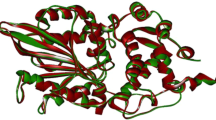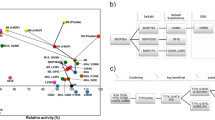Abstract
Despite recent advances in our understanding of the importance of protein surface properties for protein thermostability,there are seldom studies on multi-factors rational design strategy, so a more scientific, simple and effective rational strategy is urgent for protein engineering. Here, we first attempted to use a three-factors rational design strategy combining three common structural features, protein flexibility, protein surface, and salt bridges. Escherichia coli AppA phytase was used as a model enzyme to improve its thermostability. Moreover, the structure and enzyme features of the thermostable mutants designed by our strategy were analyzed roundly. For the single mutants, two (Q206E and Y311K), in five exhibited thermostable property with a higher success rate of prediction (40 %). For the multiple mutants, the themostable sites were combined with another site, I427L, we obtained by directed evolution, Q206E/I427L, Y311K/I427L, and Q206E/Y311K/I427L, all exhibited thermostable property. The Y311K/I427L doubled thermostability (61.7 %, and was compared to 30.97 % after being heated at 80 °C for 10 min) and catalytic efficiency (4.46 was compared to 2.37) improved more than the wild-type AppA phytase almost without hampering catalytic activity. These multi-factors of rational design strategy can be applied practically as a thermostabilization strategy instead of the conventional single-factor approach.




Similar content being viewed by others
References
Abraham T, Pack SP, Yoo YJ (2004) Stabilization of Bacillus subtilis lipase A by increasing the residual packing. Biocatal Biotransform 23:217–224
Akasako A, Haruki M, Oobatake M, Kanaya S (1997) Conformational stabilities of Escherichia coli RNase HI variants with a series of amino acid substitutions at a cavity within the hydrophobic core. J Biol Chem 272:18686–18693
Chan CH, Yu TH, Wong KB (2011) Stabilizing salt-bridge enhances protein thermostability by reducing the heat capacity change of unfolding. PLoS One 6:e21624
Dominy BN, Minoux H, Brooks CL (2004) An electrostatic basis for the stability of thermophilic proteins. Proteins 57:128–141
Eijsink VG, Bjørk A, Gåseidnes S, Sirevåg R, Synstad B, van den Burg B, Vriend G (2004) Rational engineering of enzyme stability. J Biotechnol 113:105–120
Eijsink VG, Gåseidnes S, Borchert TV, van den Burg B (2005) Directed evolution of enzyme stability. Biomol Eng 22:21–30
Eric R, Zachary A, Wood P, Andrew K, Xin GL (2000) Site-directed mutagenesis improves catalytic efficiency and thermostability of Escherichia coli pH 2.5 acid phosphatase/phytase expressed in Pichia pastoris. Arch Biochem Biophys 382:105–112
Fu Y, Ding Y, Chen Z, Sun J, Fang W, Xu W (2010) Study on the relationship between cyclodextrin glycosyltransferase thermostability and salt bridge formation by molecular dynamics simulation. Protein Pept Lett 17:1403–1411
Haefner S, Knietsch A, Scholten E, Braun J, Lohscheidt M, Zelder O (2005) Biotechnological production and applications of phytases. Appl Microbiol Biotechnol 68:588–597
Han YM, Lei XG (1999) Role of glycosylation in the functional expression of an Aspergillus niger phytase (phyA) in Pichia pastoris. Arch Biochem Biophys 364:83–90
Han YM, Wilson DB, Lei XG (1999) Expression of an Aspergillus niger phytase gene (phyA) in Saccharomyces cerevisiae. Appl Environ Microbiol 65:1915–1918
Joo JC, Pohkrel S, Pack SP, Yoo YJ (2010) Thermostabilization of Bacillus circulans xylanase via computational design of a flexible surface cavity. J Biotechnol 146:31–39
Joo JC, Pack SP, Kim YH, Yoo YJ (2011) Thermostabilization of Bacillus circulans xylanase: computational optimization of unstable residues based on thermal fluctuation analysis. J Biotechnol 151:56–65
Kim SJ, Lee JA, Joo JC, Yoo YJ, Kim YH, Song BK (2010) The development of a thermostable CiP (Coprinus cinereus peroxidase) through in silico design. Biotechnol Prog 26:1038–1046
Kumar S, Tsai CJ, Nussinov R (2000) Factors enhancing protein thermostability. Protein Eng 13:179–191
Lazar GA, Handel TM (1998) Hydrophobic core packing and protein design. Curr Opin Chem Biol 2:675–679
Lim D, Golovan S, Forsberg C, Jia Z (2000) Crystal structures of Escherichia coli phytase and its complex with phytate. Nat Struct Biol 7:108–113
Missimer JH, Steinmetz MO, Baron R, Winkler FK, Kammerer RA, Daura X, Van Gunsteren WF (2007) Configurational entropy elucidates the role of salt-bridge networks in protein thermostability. Protein Sci 16:1349–1359
Querol E, Perez-Pons JA, Mozo-Villarias A (1996) Analysis of protein conformational characteristics related to thermostability. Protein Eng 9:265–271
Pack SP, Yoo YJ (2003) Protein thermostability: structure-based difference of residual properties between thermophilic and mesophilic proteins. J Mol Catal B Enzym 111:257–264
Ragone R (2001) Hydrogen-bonding classes in proteins and their contribution to the unfolding reaction. Protein Sci 10:2075–2082
Reetz MT, Carballeira JD, Vogel A (2006) Iterative saturation mutagenesis on the basis of b factors as a strategy for increasing protein thermostability. Angew Chem Int Ed 45:7745–7751
Reetz MT, Soni P, Fernández L (2009) Knowledge-guided laboratory evolution of protein thermolability. Biotechnol Bioeng 102:1712–1717
Selle PH, Aaron J, Cowieson AJ, Ravindran V (2009) Consequences of calcium interactions with phytate and phytase for poultry and pigs. Livestock Sci 124:126–141
Strop P, Mayo SL (2000) Contribution of surface salt bridges to protein stability. Biochemistry 39:1251–1255
Szilágyi A, Závodszky P (2000) Structural differences between mesophilic, moderately thermophilic and extremely thermophilic protein subunits: results of a comprehensive survey. Structure 8:493–504
Thomas AS, Elcock AH (2004) Molecular simulations suggest protein salt bridges are uniquely suited to life at high temperatures. J Am Chem Soc 126:2208–2214
Vieille C, Zeikus GJ (2001) Hyperthermophilic enzymes: sources, uses, and molecular mechanisms for thermostability. Microbiol Mol Biol Rev 65:1–43
Vieille C, Zeikus JG (1996) Thermozymes: identifying molecular determinants of protein structural and functional stability. Trends Biotechnol 14:183–190
Woolfson DN (2001) Core-directed protein design. Curr Opin Struct Biol 11:464–471
Yip KS, Stillman TJ, Britton KL, Artymiuk PJ, Baker PJ, Sedelnikova SE, Engel PC, Pasquo A, Chiaraluce R, Consalvi V (1995) The structure of Pyrococcus furiosus glutamate dehydrogenase reveals a key role for ion-pair networks in maintaining enzyme stability at extreme temperatures. Structure 3:1147–1158
Zhu W, Qiao D, Huang M, Yang G, Xu H, Cao Y (2010) Modifying thermostability of appA from Escherichia coli. Curr Microbiol 61:267–273
Acknowledgments
This work was supported by National Science Funds Committee (30740055, 31171447, C130404, J1103518), National twelfth five-year science and technology support program (2011BAD14B05, 2013BAD10B01), and Sichuan Science and Technology Bureau (2012GZ0008).
Author information
Authors and Affiliations
Corresponding author
Rights and permissions
About this article
Cite this article
Fei, B., Xu, H., Cao, Y. et al. A multi-factors rational design strategy for enhancing the thermostability of Escherichia coli AppA phytase. J Ind Microbiol Biotechnol 40, 457–464 (2013). https://doi.org/10.1007/s10295-013-1260-z
Received:
Accepted:
Published:
Issue Date:
DOI: https://doi.org/10.1007/s10295-013-1260-z




